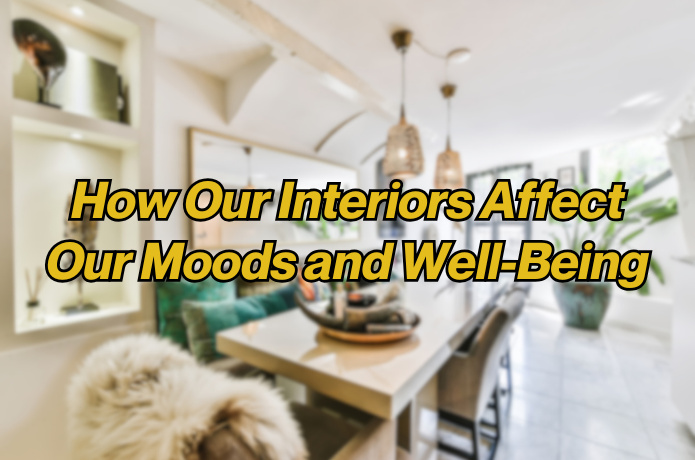How Our Interiors Affect Our Moods and Well-Being
How Our Interiors Affect Our Moods and Well-Being

The spaces we live and work in have a strong effect on how we feel. From the colour of our walls to the furniture we use and the amount of sunlight that enters the room, interior design can play a big role in shaping our emotions, energy levels, and overall well-being. Many people don't realize that making small changes to a space—like choosing the right lighting or reducing clutter—can improve mood, reduce stress, and even help with sleep and focus.
Understanding how interior design impacts our mental health can help us make better choices when decorating or organizing our homes. Whether you live in a small apartment or a large house, you can create a space that feels calm, comfortable, and supportive. In this article, we’ll explore how colours, lighting, layout, natural elements, and noise levels inside a space can affect your mood and mental well-being—and how you can use these elements to create a more peaceful home environment.
The Role of Colour in Interior Design and Mood
Colour is one of the most powerful elements in interior design. It can influence our feelings without us even realizing it. Warm colours like red, orange, and yellow can make a room feel lively and cheerful. These are great for areas where people gather, like kitchens or dining rooms. On the other hand, cool colours like blue, green, and soft purple are calming and are often used in bedrooms or reading spaces to help people relax and unwind.
Soft, neutral colours such as beige, grey, or light brown can create a sense of balance and peace. Too many bright colours in one room may feel overwhelming, while very dark colours can make a space feel smaller or sad. Choosing the right colour for each room in your home can help create the mood you want. If your goal is a stress-free home, consider using gentle tones and avoiding very bold colours in your main living spaces.
Natural Light and Artificial Lighting
Lighting has a big effect on how we feel in a space. Natural light, especially sunlight, helps improve our mood and energy. Rooms with large windows or skylights often feel more open and welcoming. Sunlight also helps regulate our body clock, which improves sleep and focus. Try opening curtains or blinds during the day to let in as much light as possible.
When natural light isn’t available, artificial lighting is the next best thing. Warm white lights can create a cozy feeling, while cool white lights are better for focus and energy. Dimmable lights give you control over the mood of a room. For example, you can use soft lighting in the evening to wind down, or bright lighting during the day when working or cleaning. Good lighting design is essential for a happy and healthy home.
Space and Layout Matter
The way a room is set up can change how you feel when you walk into it. A crowded or cluttered space may cause stress, while an open and well-organized room can create a sense of calm. Interior layout also affects how easy it is to move through a space. A room that flows well can feel larger, more relaxing, and more useful.
Try to arrange furniture in a way that feels balanced. Avoid blocking windows or walkways, and keep essential items within reach. Even in small rooms, using shelves and smart storage options can help reduce clutter. Minimalist home decor has become more popular in recent years because it promotes mental clarity and calm. Keeping things simple and organized can greatly improve your mental well-being at home.
Bringing Nature Indoors
Adding natural elements to your interior spaces can improve mental health and create a stronger connection to nature. This approach, known as biophilic design, includes houseplants, natural wood, stone, and other materials that remind us of the outdoors. Studies have shown that being around plants can lower stress levels, improve focus, and even boost creativity.
Houseplants are an easy and affordable way to introduce nature into your home. Some low-maintenance options include snake plants, pothos, and peace lilies. If you don’t have a green thumb, even images of nature or the use of natural textures like rattan or wood can have a calming effect. The goal is to create a relaxing home environment that helps you feel grounded and at peace.
Sound and Acoustics in Your Home
Noise can have a surprising effect on our mental well-being. Loud, unexpected, or constant sounds can cause anxiety and make it hard to concentrate or sleep. On the other hand, quiet spaces—or those filled with soothing sounds—can reduce stress and help with relaxation. That’s why acoustic design is an important part of home decor and interior design.
If you live in a noisy area, consider adding soft furnishings like rugs, curtains, and cushions to absorb sound. These materials can reduce echo and make a room feel more peaceful. You can also use calming background sounds, such as soft music or nature sounds, to improve your mood. A calm space with gentle noise levels supports good mental health and helps you recharge.
Personal Touches and Emotional Comfort
Finally, the items you choose to display in your home affect how you feel. Personal items like family photos, travel souvenirs, or handmade crafts can make a space feel more comfortable and familiar. A home that reflects your personality and memories helps build emotional comfort, which is important for mental well-being.
While it's important to keep your space tidy and clutter-free, don’t be afraid to add a few meaningful touches. Choose items that make you smile or bring good memories. A cozy blanket, a favourite chair, or a shelf with your favourite books can all help create a relaxing space that supports your mood and emotional health.
Interior design is more than just choosing stylish furniture and trendy colours. It’s about creating spaces that support our health and happiness. From the colour on the walls to the amount of sunlight and the way furniture is arranged, every choice we make in our homes can affect how we feel.
By learning how interiors affect mood and mental well-being, we can design homes that feel calm, supportive, and welcoming. Using soft colours, natural light, thoughtful layout, and personal touches, anyone can turn their space into a peaceful place to live, work, and rest. Whether you’re making small changes or planning a full room makeover, paying attention to how your home makes you feel is a great first step toward a happier and healthier life.

